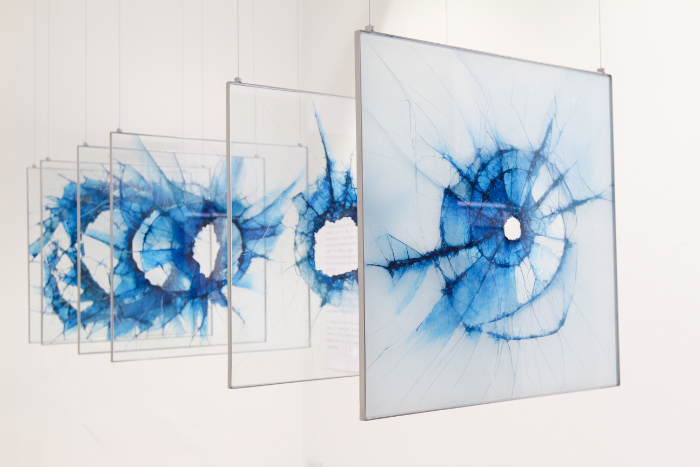
“I am Yorgos”
Glass artist Yorgos Papadopoulos became fascinated with the potential of glass after accidentally breaking a sheet of laminated glass and seeing beauty in the result. Now, 20 years later, his art still follows that trajectory; glass is his canvas and hammers are his brushes. Who is Yorgos? Read on to find out.
There is a famous laïko [Greek folk music] song with the title ‘I am Yorgos and I never sing…’ It describes a man who hasn’t found the strength to follow his passion. This is totally the opposite of Cyprus-born glass artist Yorgos Papadopoulos, who sings his way through all of life’s challenges, albeit often disrespecting the rules of pitch and harmony.
Unlike many artists, Yorgos was supported to develop his natural talents from a young age, particularly by his mother. She had had to give up her own artistic goals for a more ‘decent’ career, to be a good wife and mother. Later, when Yorgos successfully established an independent, self-sustaining art practice, he was generously supported by his family.

Initially, Yorgos was most interested in ceramics. He stumbled into glassmaking literally by accident. When studying at the Royal College of Art (RCA) in London, where glass and ceramics are one department, he broke a piece of laminated glass. We don’t need to be superstitious to feel some sadness, or even anxiety, when glass breaks. It is generally considered to render the material useless and dangerous, either in reality, or metaphorically. But, for Yorgos, it revealed a kind of beauty.
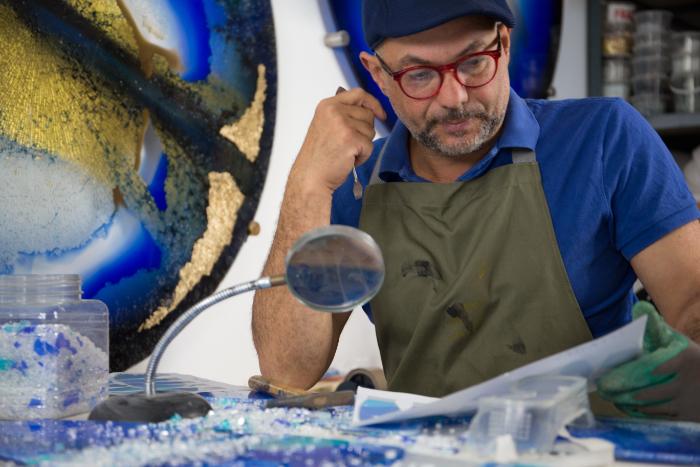
Through much experimentation from that point, Yorgos developed his technique of laminating art glass. At first, he mainly broke industrially laminated glass. He saw the creative potential of this type of safety glass, which has a plastic interlayer that keeps it together when broken. He learned how to make specific images or patterns in the cracks using different types of hammer. Although never fully in control of the breakage, he has developed a certain skill over the years to guide the effect he wants.
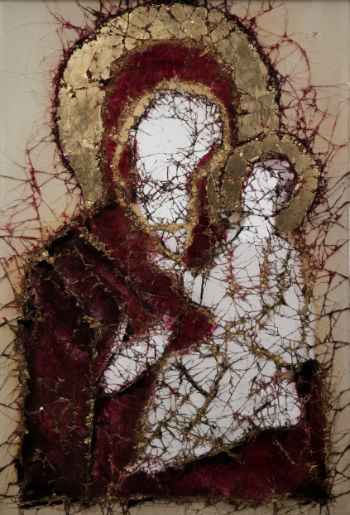
The duality between control and lack of control is best demonstrated in the artwork ‘Faceless’. Part of the ‘New Icons’ series, this image of the Virgin Mary did not have a face painted on, because the lines appeared naturally in the breakage. It is as though the work is ‘acheiropoieton’ – i.e. ‘made by itself’.
Sometimes Yorgos uses sandblasting to control the transparency of the glass. The broken sheets are then treated with inks, enamels, or gold or silver leaf. Here Yorgos manages to ‘pluck the daisies’ – to paraphrase the laïko song: from the simplicity of a piece of plain, broken glass he almost effortlessly creates a seductively beautiful image. The combination of layers and materials offers a whole world of options with which to play.
The artwork is laminated again, on one or both sides, to secure the image for posterity. The silicone gel used for this purpose is a good carrier of colours and textures, bringing a great deal of chance to how the art will evolve. There are many elements that determine the flow and curing of the gel, such as temperature, pressure and viscosity. It is this lack of control that excites Yorgos. And, if the result is not as good as he had hoped, he knows he can always put the hammer to it… Nothing is wasted.
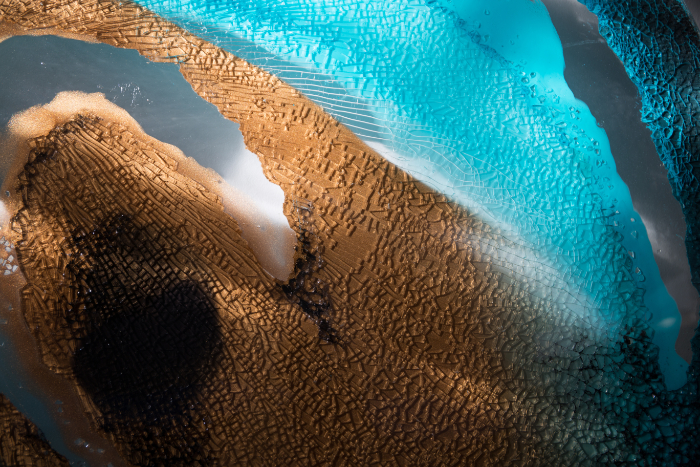
Yorgos is greatly inspired by the Japanese principles of ‘wabi-sabi’, a way of living that focuses on finding beauty within the imperfections of life and peacefully accepting the natural cycle of growth and decay. In this way, he is fascinated by the setting of concrete, the cracking of paints and the stains of wear and tear on buildings and structures. It allows him to give his art a poignant message of healing beauty.
Yorgos is not protective of the unique techniques he has developed. In 2004 he published a book on lamination and in 2015 he gave a masterclass at the prestigious Pilchuck glass school, near Seattle, USA.
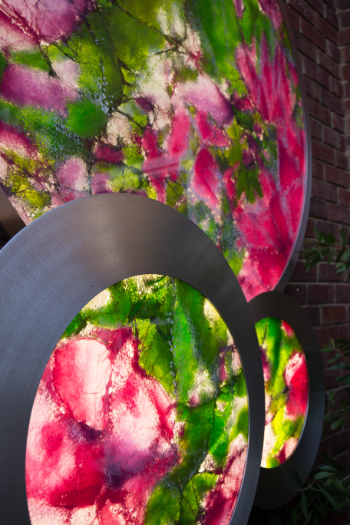
This year Yorgos’ work has been selected for the Larnaca Biennale and he is again representing Cyprus at the international glass biennial European Glass Context in Bornholm, Denmark. The work selected for this exhibition is called ‘Ripples of Time’ (illustrated in main photo, above). It analyses the principle of beauty and imperfections within the dimension of time. Ripples of Time consists of six panels which are hung as a timeline, at distances commensurate with certain significant dates in the life of the artist; dates when he is more reflective on life itself and its deeper meanings. It starts with the moment where, at the age of four, Yorgos and his family had to flee their home town of Famagusta because of the Turkish invasion.
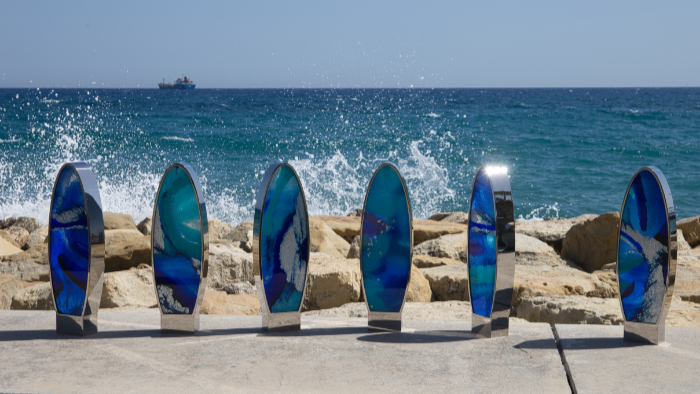
With his most recent work, ‘Les Naïades Chantantes’, Yorgos shows his commitment to the spatial relevance of his art. He was commissioned to create something for the spa area on deck 9 of the new MS Rotterdam. This is the seventh cruise ship by that name that is being built for Holland America Lines. For this project Yorgos made six glass sculptures, consisting of two glass panels each, which are held in oval frames of marine grade, mirror polished stainless steel. The sculptures are individually lit from inside their bases and are positioned around a circular pool. The images in the glass link in such a way that it seems the sculptures are harmoniously singing together.
Soon Yorgos will be taking the spatial element of his practice literally to the next level by building the first real-world Reflectorium. This will be a room, primarily made using art glass, that will sit on top of his current studio, as though it has landed from outer space. The studio is situated in Kedares, which is a small and traditional Cypriot village in the foothills of the Troodos mountains. Nothing in this village has any serious appeal from a modern architectural point of view, but the Reflectorium will change that. Form will be independent of function, with a meditative chamber where art can be both experienced and imagined.
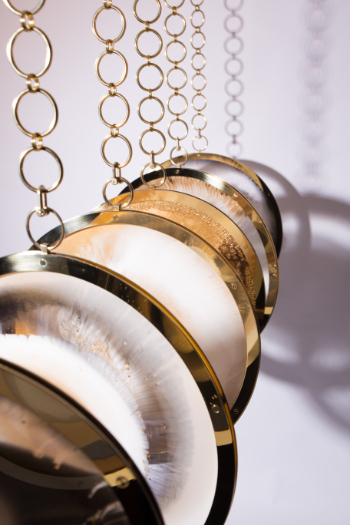
Yorgos’s work has been sold around the world, from Hong Kong to Cape Town to San Francisco and anywhere in between. He is represented in London by Vessel Gallery and Railings Gallery, and in Cyprus by Alpha C.K. Art Gallery in Nicosia and Chakra Gallery in Paphos. For commissions on superyachts, cruise liners and airplanes he collaborates with Artelier in Bristol and ICArt in Oslo and Miami.
When Yorgos was graduating from the RCA, the external examiner asked him to define himself and his work within the wider context of the arts. Slightly baffled by the question, he spontaneously answered “I am Yorgos!” There is just no other way of defining him.
About the artist
Yorgos Papadopoulos was born in 1969 in Limassol, Cyprus. Following an Art & Design Foundation at Middlesex Polytechnic, London (1988), he took a BA (Hons) Interior Design at Middlesex University, London (1993), followed by a Ceramics Diploma – City Lit, London (1997) and an MA in Ceramics & Glass at the Royal College of Art, London (1999).
He has taught and lectured at art institutions in the UK and taught a masterclass at Pilchuck School of Glass, Seattle WA, USA, in 2015.
His work has been exhibited internationally and he has undertaken commissions around the world.
Find out more via his website.
Article written by Arjen De Neve.
Main feature image: ‘Ripples of Time’. Photo: Elena Alonefti Fitikidou.